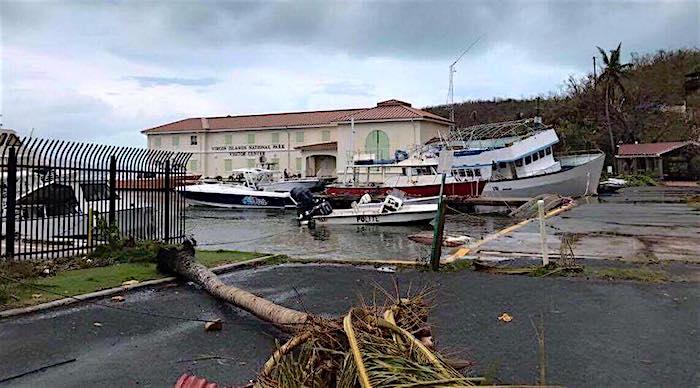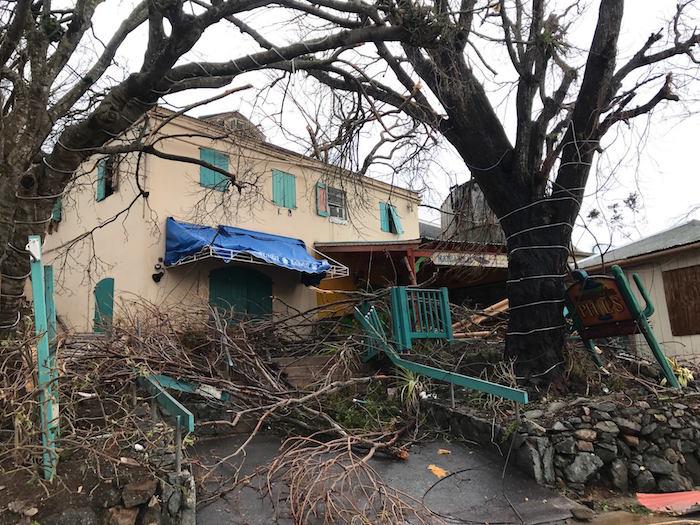
This shot by Kyle Bilik, posted September 7 on the What's Going On, St. John, US Virgin Islands, Facebook page, shows some of the damage Hurricane Irma inflicted at Virgin Islands National Park's headquarters/Kyle Bilik
Editor's note: This updates with statement from acting National Park Service Director Michael Reynolds that help has arrived at Virgin Islands National Park. If you're on St. John and have information regarding storm damage or rescue and cleanup efforts, please email details to [email protected]
Two days after the strongest Atlantic hurricane on record raked through the Caribbean, tossing boats about like toys and ripping roofs from buildings, help arrived Friday at the island of St. John to begin the recovery of Virgin Islands National Park, where all employees were accounted for and safe.
"We are pleased to be able to report that all NPS staff in the Caribbean parks are safe, are not in any danger, and have food, water, and shelter," acting National Park Service Director Michael Reynolds said. "We have worked with federal and local officials to evacuate employees who remained in the Virgin Islands and have transported emergency personnel to St. John to assist with emergency services, assessments and initial recovery."
On the mainland, meanwhile, Director Reynolds said that all national park units throughout Florida and along the Georgia coast were closed because of the approach of Hurricane Irma, and that all non-emergency personnel were released.
On St. John, with phone service and electricity disrupted, people turned to satellite phones and ham radio operators to communicate and organize rescue operations.
It's perhaps both a blessing and a curse that the national park takes up roughly 60 percent of the island of St. John. With just one main road crossing the island from Cruz Bay to Coral Bay, Centerline Road, and it surrounded mostly by mountainous landscape covered in thick forests, there is relatively little development when compared to neighboring St. Thomas. But in the wake of the storm, trees and other vegetation clogging the road made travel slow if not impossible.
"We are in communications with FEMA and Red Cross on the ground in (St. Thomas), and working to get links to (St. John) relief workers via known satellite phone in Coral Bay, (St. John) HAM radio operators with connectivity to (St. Croix), and via the text/facebook connections we have with folks in Cruz Bay until communications can be established with the (Emergency Operations Center) in whatever new location they can set up in. Number one priority today is communications, shelter and feeding," read a post Friday on the St. John Community Foundation Facebook page.
Foundation staff also were collecting information on available housing for displaced inviduals and relief workers. Providing meals was another problem they were grappling with.
"We do not know yet the state of feeding capability at the shelters until we can establish contact. One shelter was 'compromised' and the folks had to be moved," the Facebook post said. "Details to come. Aaron from Fishtrap has offered his kitchen (after assessment), and Neil on the ground in (St. John) has access to Freshwater equipment. We will be sending details on who will be setting up public feeding sites. I know that people are taking any usable food to neighbors who have generators for storage and cooking.
"... More to come...another post to follow for people on the ground for how to determine structural integrity... Reported injuries are few, let's keep it that way!"
National Park Service officials in Atlanta said Virgin Islands National Park "sustained extensive damage, the extent of which is currently being assessed. The park currently has no external power or water, but is operating on generators and has stored supplies and water for staff."
"Parks located on the island of St. Croix (Christiansted National Historic Site and Salt River Bay National Historical Park) suffered less damage," according to the Atlanta office. "They have external water and sporadic power and are currently closed. San Juan National Historic Site in Puerto Rico sustained minor damage according to initial reports. The park is currently without power and will remain closed until further notice."

But while islanders and Park Service staff were working Friday to recover from Hurricane Irma, another threat was on the horizon, as Hurricane Jose, a Category 4 storm, was bearing down on the Virgin Islands and forecast to strike St. John and St. Thomas as Saturday morning, possibly as a tropical storm.
On Facebook, pages were created to serve as collectors for news, pleas for help in searching for friends and family, and details on destruction left by the Category 5 hurricane that ravaged many areas of the Caribbean.
"CORAL BAY has reported in!!! Devastation is complete, but people are ok!," read a post from Thursday on the St. John Community Foundation Facebook page. "No serious injuries reported! In fact, a volunteer medic walked across island and only had to bandage 1-2 people along the way. ... Emergency Communications Equipment and Fuel is needed if the EOC or other government agencies get this message. Contact with the (Emergency Operations Center) has not been reestablished post storm as of this post, but we know they are up an running! Telephone poles block most streets, so on foot it is if you are getting around. Remember, do not remove poles because WAPA and phone lines intermingle and if you damage lines any more than they already are, according to VIYA's Jennifer Matteragus-King, service restoration will be even more difficult."

Hurricane Hole adjacent to Coral Bay on the island of St. John long has been used as safe harbor from hurricanes for boats/NOAA
U.S. Virgin Islands government officials had said that St. Thomas and St. John took the brunt of the hurricane. On Thursday, a report from Virgin Islands National Park described the island of St. John as suffering "total devastation."
The report, relayed through a ranger at Biscayne National Park, was from a ranger at Virgin Islands.
"I stayed in park housing with others and we are all safe. Our houses are destroyed and we see that another hurricane is on the way," said the ranger. "We are hoping to be evacuated if we can figure out a way. Total devastation to the island. Our houses and structures are not habitable..We know the employees with us (about 20) are OK, but don't yet know about the rest. We will update when we can. Please send prayers and help!"

Downtown Cruz Bay on St. John sustained heavy damage/Siobhan Soleil Mulvey via Facebook
At San Juan National Historic Site in Puerto Rico, park officials reported that, "(T)he historic forts sustained minor damage and all employees of the San Juan National Historic Site are safe."
There were no reports from Christiansted National Historic Site on St. Croix.



Comments
Praying for you all! Hope help comes soon.
I agree with all of this too. A good hurricane hole can be an invaluable resource when a large storm is pressing. However, do not be misguided. If a Category 4 or 5 storm hits directly, no marina will be safe.
http://hurricanehole.org